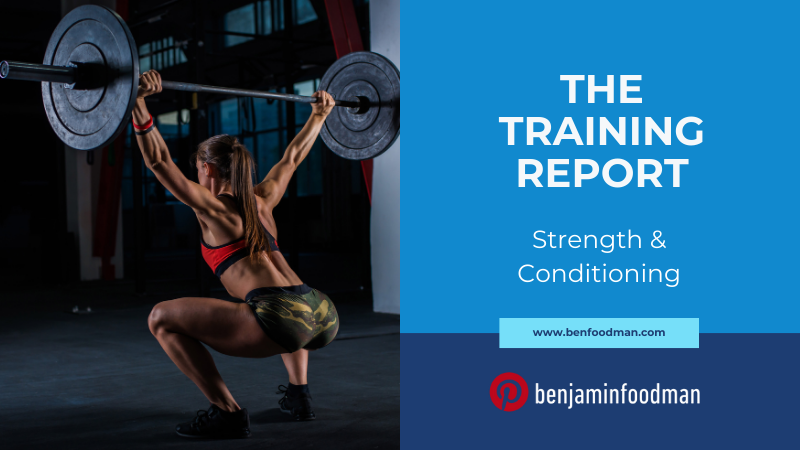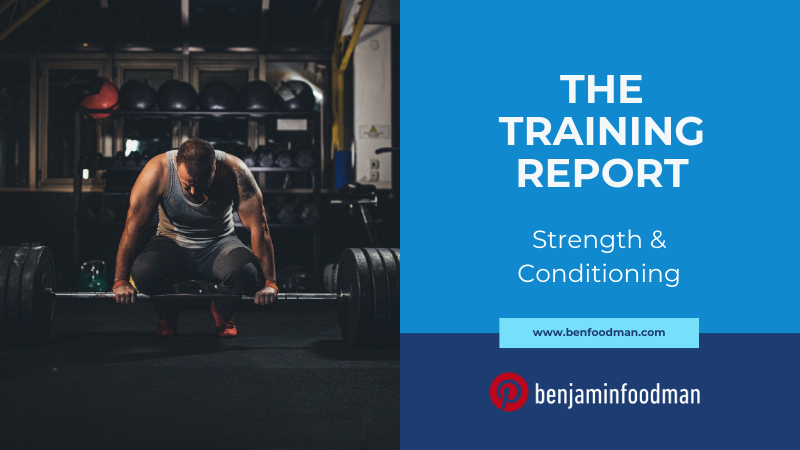Strength & Conditioning - Exercise Science Periodization Strategies Part IV. Agility & Quickness
About the Author
Ben Foodman is a licensed psychotherapist & performance specialist. He owns his private practice located in Charlotte North Carolina where he specializes in working with athletes to help them overcome mental blocks (the yips), PTSD, ADD / ADHD and achieve flow states through the techniques of Brainspotting & Neurofeedback. If you are interested in services, use the link here! Enjoy the article below!
Table Of Contents
Introduction: Strength & Conditioning Principles For Developing Agility & Quickness In Explosive Athlete Populations
When athletes work with exercise science professionals such as Certified Strength & Conditioning Specialists, they are usually trying to enhance their physical performance in specific domains of their sport. This is sometimes referred to as sport-specific training. Basically, certain sports over emphasize the use of certain energy systems or certain movement patterns. For example, elite marathon runners are usually training sagittal plane movements whereas baseball players focus on transverse plane movements.
But regardless of what sport athletes participate in, almost all athletes will benefit from developing agility and quickness in their sport. Because there are many questions that athletes have about this style of training, I wanted to take the time to discuss specific training strategies as well as how athletes can mentally benefit from this style of exercise. In part I. I will review the basics of speed and agility training. In part II. I will explore training concepts for these movements. In part III. I will provide a sample program and in part IV. I will review the mental benefits.
Part I. Understanding The Basics Of Speed & Agility In Strength & Conditioning
When reviewing the National Strength & Conditioning Sport Performance Series Developing Agility and Quickness the authors state the following: According to numerous coaches and sport scientists, an agility task is a rapid, whole-body change of direction or speed in response to a stimulus. Agility can be broken down into subcomponents made up of both physical qualities and cognitive abilities. In regards to the subcomponent of speed, athletes who can move faster than their opponents have an advantage. For this reason, athletes in most sports highly value speed. Speed is often measured by using linear (straight-line) sprinting over a distance between 40 and 100 yards. Regardless of sport, understanding the specific definitions around speed and agility are important because the training strategies will be significantly different as opposed to training other systems in the body (e.g., aerobic and/or phosphagen system).
But why would it be important to train quickness and agility in explosive athletes? And how is constructing a program design different for these athlete features compared to endurance-based athletes or other sports? Many sports require athletes to be able to make change of direction at rapid speeds while also maintaining explosive power throughout the competition. Obviously, the faster athletes can decelerate and reaccelerate compared to their peers, the more likely they are to out perform them in competition. In regards to programming differences, speed and agility training will focus on specific exercises, rep schemes and load percentages as opposed to other sports that place preferential treatment on certain energy systems (e.g., endurance resistance training utilizes 12+ rep range scheme with 50-70% load intensities whereas speed and agility resistance-based training stays around 80% load intensity for 2-3 rep range with longer rest periods).
Part II. Agility, Quickness And Specificity Of Training For Explosive Athletes
One of the aspects of strength & conditioning that coaches and athletes look forward to the most, is which drills and exercises they will incorporate into their training. As previously mentioned, there are specific training interventions that athletes and coaches should use when training these systems. Per the NSCA: Not every drill is appropriate or should be used for all athletes. Coaches should examine each drill to see where it fits with the level of specific athletes. Using proper progression is important when implementing any training element into a program and the same is true with agility drills. Proper progression follows these guidelines:
Level 1 (Basic) agility focuses on technique and body position. This level uses basic cuts and movement patterns
Level 2 (Intermediate) agility combines more complex movement patterns and involves transitional movements, good body mechanics and position, and change-of-direction speed that require higher levels of force and power
Level 3 (Advanced) agility uses skills and drills that mimic real game or competitive situations
Now that we have covered important considerations for exercise selection, lets take a look at different drills athletes and coaches can use to enhance agility and quickness.
Level 1 Line Drill, Traveling Scissors - The athlete stands with shoulders parallel to the line and then steps across the line to straddle it with one foot in the front of the line and the other behind it. She rapidly alternates the position of the feet, moving them forward and backward in a scissor like motion while moving laterally down the line for a specified time period or a predetermined distance. This drill should be performed to both the right and left sides to ensure balanced training.
Level 2 Ladder Drill, Cherry Pickers - The athlete stands at the end of the ladder with hips and shoulders parallel to the rungs. She hops forward and lands with one foot outside box 1 and the other foot in the center of it. The athlete bends forward, reaches down with the hand opposite the foot in the box, and touches the ground directly in the front of the foot in the box. The athlete then hops into box 2, switching the leg position so that the outside leg goes to the center of the box and the inside leg lands outside it. She bends down and again touches the ground in front of the leg in the box with the opposite arm. The athlete continues this drill down the ladder, alternating foot and hand positions. This drill can also be performed moving backward.
Level 3 Reaction Drill Reactive Sprint and Backpedal Drill - This drill improves the ability to accelerate and decelerate while running forward and backward, such as when covering an opponent in a variety of sports. Begin this drill by placing two cones 10 yards apart. The athlete begins by standing in an athletic position at cone 1. One the go signal, the athlete runs forward toward cone 2. When the coach says switch, the athlete immediately decelerates and changes directions, backpedaling to cone 1.
Now that we have covered sample drills that athletes can use, let’s finally review specific drills and tips that individuals should consider when designing a periodization program for enhancing agility and quickness. (Part III. is meant to be a sample, athletes should always directly consult their healthcare providers whether these interventions are appropriate for their health needs)
Part III. Sample Training Exercises For American Football Players
Drills And Tips
The following is an excerpt from the National Strength & Conditioning Association’s Developing Agility and Quickness Sport Performance Series
Football coaches and athletes can use a variety of drills. Some recommendations for using the different types of drills follow. The setup of the drills (distance travelled, duration, and so on) determine the degree of specificity for each position.
Line drills - Performing any of the lateral line drills are great for improving transitions on the field. Coaches can vary the distance and movement paterns to make them position specific
Ladder drills - Coaches may vary the movement patterns, distance, and variety based on athletes’ skill levels and positions
Dot drills - Coaches may vary the movement patterns and add stimuli, based on the athletes’ ability and the movement progression
Cone drills - Coaches should use a variety of patterns. They can change the number of cones and the distances for each drill to match the skills of the athletes
Specific agility drills - The pro-agility drill, T drill, and combinations of other patterns and movements are useful for football
Keep the following tips in mind when training agility and quickness for football athletes:
To be quicker, athletes must learn how to stop. Deceleration is a major contributor for improving overall agility and quickness. The faster players can stop, the sooner they can start again. This also helps prevent injuries, such as hamstring injuries.
Agility training should focus on reducing or minimizing the time between the eccentric and concentric action of a movement. Doing so allows athletes to produce the required force in the shortest amount of time.
Athletes must use an overall strength and conditioning approach to become quicker. To maximize results, players must have efficiency of movement, which involves coordination, dynamic balance, proprioception, and flexibility, in addition to overall body strength and power.
Any muscle imbalances in strength or flexibility ultimately impede agility, quickness, and overall performance. Likewise, muscle imbalance can lead to injury.
Athletes should perform agility and quickness drills early in the routine when the nervous system is still fresh. The movement portion of the program can be incorporated right into the warm-up or can be done immediately after a 10 to 15 minute routine that includes a dynamic warm up and joint integrity drills.
Athletes should focus on performing agility and quickness drills for quality, not just pure volume.
Part IV. Exercise Psychology Benefits Of Speed & Agility Training
In addition to the physical benefits of speed & agility training, there are incredible mental benefits as well, which may be just as important. When we look at the research, what we see is that athletes who regularly train will accumulate the following mental benefits: new brain cells which increase the volume of the hippocampus which improves long-term memory, improved attention function, and long lasting increases in mood and focus. When you think about the psychological demands of sports, it’s easy to understand why it would be critical for athletes to improve in these areas. Furthermore athletes are ‘hitting two birds with one stone’ by training both the mind and body during strength training, which in turn is much more time efficient.
Note To Reader:
If you are an athlete reading this segment of the TRAINING REPORT, hopefully this content was helpful! I put the Training Report together because I felt like many of the discussions on issues such as the Yips/mental blocks, strength training & other subject matter on athlete performance concepts were really missing the mark on these ideas (e.g. how trauma is the direct cause of the Yips). If you are interested in learning more, make sure to subscribe below for when I put out new content on issues related to sport psychology & athlete performance! Also, if you are looking to work with a mental performance specialist, you are in the right place! USE THIS LINK to reach out to me to see if my services are the right fit for your goals!
ARE YOU ON THE LIST?
Make sure you’re signed up to Ben’s mailing list which will be emailed directly to your inbox. Don’t wait, sign up now!



























